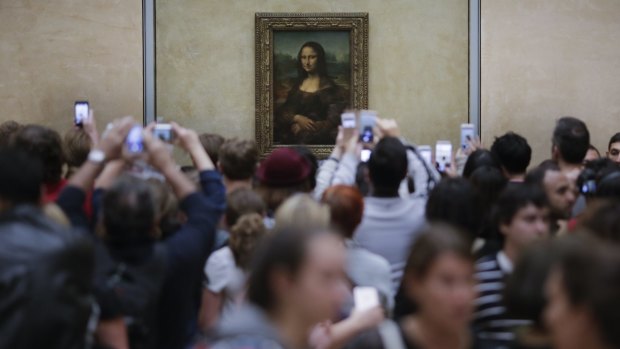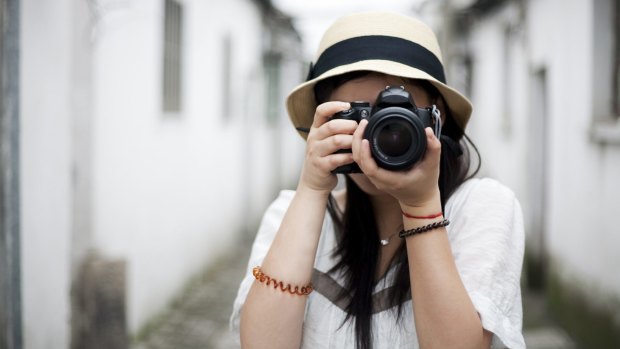This was published 7 years ago
Tips to taking photos on holidays: 10 things you're not allowed to take photos of
By Michael Gebicki

Visitors crowded in front of Leonardo da Vinci's painting 'Mona Lisa' at the Louvre. Credit: AP
Leaving Leh Airport in India's Ladakh with a tour group a couple of years ago, one of our party pulled out his iPhone to take a group shot when an army sergeant stormed over, finger wagging. "Photography is not allowed," he said, moustache aquiver. It seemed innocent enough – a final souvenir photo from a visitor in a place he was not ever likely to visit again – but the sergeant was having none of it. He stood over the photographer until the offending photos disappeared into the ether.
For about 10 kilometres either side of Leh, the Indus River Valley, in which the city sits, is virtually one big military encampment, a frontline base in an area that is claimed by China. Leh is primarily a military airport. As we stood outside a pair of twin-tailed Sukhoi fighters flew circuits above the airfield, and India doesn't want to risk its military installations appearing on social media to a watching world.
When you stroll out that world you might assume that you can snap photos of famous buildings, monuments, temples and whatever else you like but that's not always the case, and there are some truly strange exceptions.

When travelling, it's good to remember that there are some things you can't take photos of.Credit: iStock
See also: 11 mistakes every first-time traveller makes
Richard I'Anson is one of Australia's leading travel photographers. Several times a year he leads groups of keen photo enthusiasts on photo safaris to capture Buddhist festivals, the wonders of Iran or Australia's own Arnhemland, and he's been on the receiving end when officialdom takes a dim view of his photo exploits.
"I've been in trouble for photographing the Howrah bridge in Calcutta," says I'Anson.
"Another time I was shooting from a rooftop in Monaco and security told me I couldn't take photos because it was violating people's privacy, they thought I was photographing people in their apartments. France has some of the toughest privacy laws in the world. You're not even supposed to take photos on French beaches.
"Sometimes it's hard to know what the rules are. I was leading a group in Iran and we visited one of the country's most spectacular mosques, the guide sent the women to the left, the men to the right. When we came out the other side we rejoined and the women said 'we couldn't take photos', but we said 'our guide told us to take photos inside'."
According to I'Anson, there's often a dividing line between photos that an amateur snapshooter takes and those of a professional photographer, who derives an income from their work.
"A tripod is a giveaway. While you can wander around freely and shoot in most places even if you're carrying a high end digital SLR, as soon as security spots a tripod they're interested."
"My most memorable incident was when I was photographing in Moscow's Red Square. Again it was because I set up a tripod and drew attention to myself. There were plenty of people taking photos at the same time but they were all ignored. I got the shot but the police caught me before I could get away and I was threatened with arrest. I had to pay a bribe to get out of it but I bargained them down, so it only cost me 25 Aussie dollars instead of 75."
So for the amateur, non tripod toting photographer, what are some of the rules about what you can and can't shoot?
Airports
Haul out a camera at an airport security checkpoint, baggage hall or bag screener or point it at individual security personnel and you're begging for a slap-down. The layout of airports, how they're staffed and how they operate, are all interesting facts to those who would seek to circumvent the rules, or do us harm. Since airports are top-heavy with security you're unlikely to get away with it.
See also: World's best airport fine dining experience
Museums and art galleries
Some ban photography outright but most of the big-name institutions allow hand-held photography provided the camera flash is off. The reason is that light causes subtle changes in colours, and it's cumulative. The theory goes that if you blast a painting or a manuscript with enough flashes the colours will fade. How many powerful flashes it would take for that to happen is debateable but it's not an argument you want to have with a museum attendant.
Mosques and temples
Ask permission. Sometimes it will be freely given, sometimes it won't. It would be unusual to be allowed to photograph Muslim men at prayer in a mosque, or even for a non-Muslim to be permitted to remain inside at such times. Hindu temples generally forbid it within the inner sanctum and so will many Buddhist temples, although this varies from one country to another.
Churches
It's rare for a church to ban photography but one that does is Scotland's Rosslyn Chapel, made famous by Dan Brown's The Da Vinci Code. Same goes for the Sistine Chapel in Rome, and Amish churches generally forbid photos.
See also: Things you can do overseas that are banned in Australia
Defence installations
Military aircraft at airports, tanks, submarine bases, military storage facilities, naval ships, army bases and military personnel on manoeuvres or outside of bases are all sensitive subjects, and anyone with a camera showing too much curiosity is suspect. The reaction depends on how paranoid the country is.
People
It's only polite to ask before you frame someone up in your viewfinder, but there are some places where you can't. Pointing a camera at women in traditionally minded Islamic societies is likely to land you in hot water, which might be merely tepid or scalding.
Government buildings
The reaction varies enormously, and you might not find out until a security person appears in your viewfinder. In Turkmenistan all government buildings are guarded and photographing them is prohibited. It's forbidden to photograph The Pentagon in Arlington, Virginia, although in theory at least, the state's open-carry laws allow you to stroll past with a firearm. In India prominent warnings in government buildings forbid photography inside, possibly because you might catch one of the not-so-civil servants napping – not uncommon – or surrounded by toppling piles of files, which pretty much sums up India's labyrinthine bureaucracy.
See also: The world's most photogenic places, named by the experts
Railway stations, bridges, tunnels
Some countries class these as military infrastructure since they're used to transport troops and hardware. North Korea took offence when photographer Eric Lafforgue posted a series of real-life images of the hermit state, including one of a subway tunnel, and subsequently banned him from future visits. Russia feels the same about the tunnels on the Moscow metro while India doesn't like you photographing bridges.
Department stores and shopping malls
Both are protective of their real estate, and you can generally assume they have rules that forbid photography. While shopping plazas in particular might look like public space they're private property, and therefore they have a right to make rules that forbid photography. If it's a selfie of a friend on a smartphone you shouldn't have a problem but anything that looks like serious photography will probably see you collared.
Public buildings and monuments
As with government buildings there are some curious anomalies. Snap away at the Eiffel Tower by day as much as you like but if you do it at night and publish or exhibit the result, even on Facebook, you could have un probleme. The tower's amazing light show is classed as an artistic work; it's copyrighted and publishing a night image requires the permission of the copyright owner. Taking a night shot is permitted, but the end usage might not be. Parts of Ayers Rock are not allowed to be photographed for publication, which might be a website or social media, out of deference to the Aboriginal owners of the site. Well-known Australian landscape photographer Ken Duncan was shooed from Barangaroo last year when he set up a tripod, on the grounds that commercial photography at the site requires permission.
See also: Man mobbed by monkeys turned into hilarious memes
See also: Ban on scantily clad tourists at Angkor Wat
Sign up for the Traveller newsletter
The latest travel news, tips and inspiration delivered to your inbox. Sign up now.